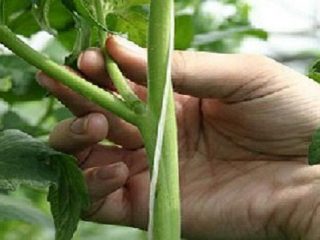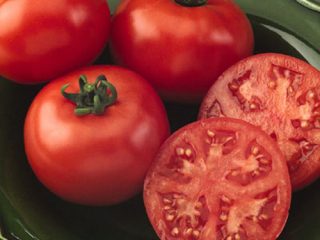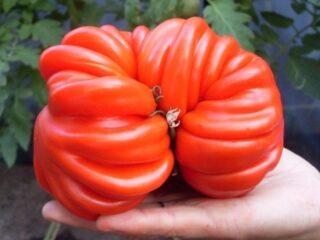Content
The Golden Klusha tomato is a mid-early universal variety that can be grown in open ground and in greenhouses. Juicy golden tomatoes look original in vegetable slices and fresh salads; they are actively used for winter preparations. Among the main advantages of the variety are its dessert taste, high yield and excellent immunity to disease.
When and who brought it out
The Golden Chestnut variety was bred by the Siberian Garden agricultural company. In 2019, he expanded the Klush series of standard tomatoes. In the short Siberian summer, the crop is grown under simple film covers.

A spreading bush with yellow tomatoes resembles a black hen protecting its chicks
Description and characteristics of tomato Golden Klusha
The Zolotaya Klusha variety is characterized by low-growing bushes of a determinate type. Their shoots are erect, powerful and strong, up to 40 cm high. They do not require pinching, gartering or shaping. The leaves are dark green, large.
Tomatoes of the Zolotaya Klusha variety are endowed with a round shape and yellow color. The weight of each fruit is 150-250 g. The dense and elastic skin guarantees protection against cracking. At the same time, it is thin and cannot be felt in food.
Inside the fruit there is juicy, aromatic pulp, fleshy and delicate in texture. It is golden in color, has few seeds, and has a very sweet taste.

The variety is distinguished by its presentation, but its shelf life is poor
Ripening time
The first harvest of the Golden Klusha tomato occurs in July and lasts until early September. The growing season lasts 100-105 days. The variety is unpretentious and bears fruit consistently regardless of weather conditions.
Tomato yield Golden Chestnut
The culture is considered high-yielding. On average from 1 sq. m plot, gardeners manage to harvest up to 10 kg of tomatoes. On average, one bush brings about 2.5 kg, which depends on the growing conditions.
Resistance to adverse factors
The Golden Chestnut variety is distinguished by its high cold resistance. The plant can easily withstand frost, temperature fluctuations and drought. But it should be taken into account that the taste of the fruit is affected by watering, the degree of soil fertility and the amount of sunlight.
Where is it grown?
The tomato is flexible, well adapted to the climate of Siberia, and guarantees stable fruiting in any weather.It can be grown in any region of Russia in open and closed ground, subject to agricultural technology.
Purpose and application
Yellow tomatoes are always in demand among gardeners due not only to their color, but also to their excellent taste. The pulp contains a large amount of vitamin C and other vitamin and mineral elements. The fleshy fruits are consumed fresh, added to vegetable cuts, snacks and other dishes, and used to prepare a variety of winter salads.

Juicy dessert pulp has ensured the fruits wide popularity in cooking
Advantages and disadvantages
The value of the variety lies in its fairly early ripening, in contrast to similar varieties. It is also worth noting the natural varietal origin of the Golden Chestnut, which allows you to prepare the seeds yourself.

The sweet taste of Golden Klusha tomatoes is liked by both adults and children
Pros:
- suitable for growing in open soils and greenhouses;
- ease of care;
- shows resistance to most diseases and is rarely damaged by insect pests;
- tomatoes do not crack and tolerate short transportation well.
Minuses:
- poor keeping quality;
- loss of quality when ripening at home.
How to plant correctly
Golden Chestnut tomatoes are grown through seedlings using loose nutritious soil with good permeability to air and water. Prepared seeds are sown towards the end of March at a depth of 1 cm under the film. They fully germinate at a temperature of +15 °C.
At the age of two true leaves, seedlings are planted in individual cups.In May or June, depending on the region, the seedlings are planted in open ground in holes according to a 40x60 cm pattern. Tomato bushes do not require staking, since they do not bend under the weight of the fruit.
Features of care
Receiving good care, a tomato shows high productivity. It is especially responsive to fertilizing, which is applied for the first time two weeks after planting. Fertilizers are then used in mid-summer and during fruit ripening.
Water the bushes twice a week using warm water heated by the sun. After moistening, the soil must be loosened and weeds removed.
Tomato fruits are harvested throughout the season as they ripen. They are for salad purposes, so they don’t store well.

Tomatoes are consumed first to prevent them from spoiling.
Is it necessary to plant the Golden Klusha tomato?
Forming and pinching tomatoes takes a lot of effort and requires certain skills. The good thing about the Golden Chestnut variety is that it does not require these procedures. Due to its unpretentiousness, it is ideal for beginners.
Treatment against diseases and pests
The Golden Klusha variety is resistant to most major diseases. Tomatoes are not afraid of diseases such as late blight, cladosporiosis and tobacco mosaic virus. However, it requires prevention to protect it from diseases and pests. A simple and effective method is to treat the bushes with iodine solution or Fitosporin-M. Against the tomato cutworm, which often plagues this variety, dusting the plants with a mixture of equal parts of wood ash, lime and tobacco powder helps.
Conclusion
Gardeners have already appreciated the Golden Klusha tomato, although it appeared not so long ago. It is grown both in open ground and under film. When you create all the necessary conditions at your summer cottage, you can count on getting a large, tasty harvest.
Reviews from summer residents about the Golden Chestnut tomato








